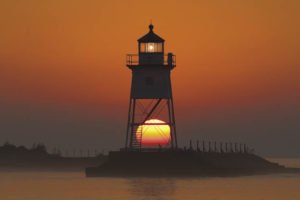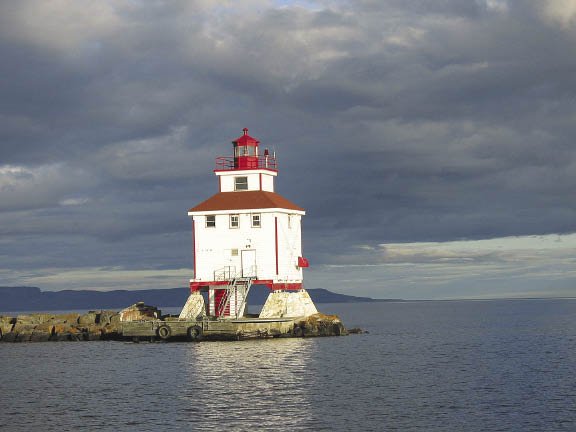Imagine looking out the window of a Lake Superior lighthouse and seeing a giant lake freighter on course to slam right into you.
It is just one of the many lighthouse tales that have become part of the Lake Superior folklore.
Lake Superior’s first lighthouses appeared in 1849 at Whitefish Point and Copper Harbour. It wasn’t until 1865—the same year Minnesota became a state—that the first lighthouse was built on Superior’s western shores at Minnesota Point. The lighthouse was nicknamed “Old Standby” and marked the entrance to the Superior-Duluth harbour.
Two years later, in the summer of 1867—the same year the Dominion of Canada was created—Canada’s first lighthouse on Lake Superior, the St. Ignace Lighthouse, was lit at Talbot Island, a place which the Ojibway warned the government was haunted by evil spirits. After the deaths of three lighthouse keepers within six years, the Canadian government abandoned their ‘’lighthouse of doom.’’ However, fishermen report that sometimes during a moonlit night, a white-haired woman (rumoured to be the widow of the second keeper) can be seen roaming the remote island.
Minnesota’s Split Rock Lighthouse, which sits on a sheer 130-foot cliff, owes its existence to a shipwreck less than a mile away. It happened in the early hours of November 28, 1905, during a raging blizzard. The 436-foot steel barge Madeira was being towed by the 478-foot steel steamer William Edenborn. About 3 a.m. the towline broke, leaving Madeira drifting and helpless. Three hours later, the Madeira was being smashed broadside against a cliff, lost a crewman, broke in two and sank. Coincidentally, at the same time a few miles away, the Edenborn slammed its bow at full speed onto the shore at the mouth of Split Rock River. She also lost one crew member as the ship cracked midship.
After the 1905 storm, shipowners lobbied successfully for a lighthouse to be built near Split Rock (then called Stoney Point).
The beautiful Battle Island about seven miles from Rossport comes with an interesting history. According to lake legends, its name comes from a battle that supposedly took place in 1885 between Canadian soldiers on their way to Manitoba to squash the Riel Rebellion and the Ojibway. The soldiers were marching across the frozen Lake Superior from Jackfish to Rossport when, along the way, the soldiers claim shots were fired at them and they returned the fire, lending to the story that a “battle” took place. A nearby island and lighthouse took on the name of Battle Island.
Battle Island’s first official keeper, Charles McKay (1877-1913), stayed for 36 years and was one of those hardy mariners who thought nothing of row-sailing 92 miles to Thunder Bay on business. Another time in early December, he rowed-sailed from Battle Island to Sault Ste. Marie to see his family, arriving on Christmas Day.
The lighthouse sits atop a rock cliff 117 feet above the water. Yet, in 1977, as the keepers huddled in their house, a ferocious summer storm pushed a huge wave up more than 100 feet, splashing right over the tower.

Built on the southeast side of Isle Royale, Menagerie Island Lighthouse was first lit on October 19, 1875 when the unmarried John Malone was the first assistant keeper. Three years later, he became the keeper and in 1880, the 35-year old Malone married 20-year old Irish woman named Julia Shea. They stayed at the isolated lighthouse for the next 34 years, raising 13 children—all named after lighthouse inspectors. The year that there were two inspectors, Julia gave birth to twins.
A creatively self-reliant couple, they grew vegetables on nearby Wright Island, had a family cow grazing on another island, gathered seagull eggs (an 1887 log entry noted 1,487 eggs collected to date), and in their spare time, stuffed birds and animals they had killed for food.
From just about anywhere in Thunder Bay, one can see the red-and-white lighthouse built in 1937 on the end of the breakwall’s north entrance to the harbour. In May 1971, the keepers had an unexpected visitor when the Canadian Steamship Lines Simcoe collided with the lighthouse and pier, causing heavy damage and cutting the submarine cables. It took four months of repairs before the keepers could return to the lighthouse.
When the lighthouse keeper at Porphyry Point, the late Dave Sokalsy of Thunder Bay, finished the season in the 1970s, his beloved cat companion was nowhere to be found when he was helicoptered back to the mainland. His friend William Hryb tells the story of the heartbroken Dave paying the costs for a helicopter ride back to Porphyry to find his lost cat. “Shortly after landing, he found his precious cat waiting at the door of the lighthouse. He bundled her up in his long coat for the ride back to the base,” said Hryb, adding the cat went on to live a long life.
Note: this story was originally published in the June-July 1012 issue of Northern Wilds Magazine.




